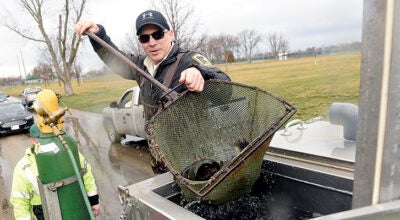Testing could start soon on possible COVID-19 treatment
Published 12:48 pm Friday, April 17, 2020
|
Getting your Trinity Audio player ready...
|
In a whirlwind of activity, Mayo Clinic and a medical device firm are fast-tracking research on an antiviral drug that looks promising to treat COVID-19.
BioSig Technologies, a collaborator with Mayo Clinic that opened a Rochester office in the Conley-Maass-Downs Building in 2019, recently acquired a broad-spectrum antiviral drug called Vicromax.
Vicromax has undergone several clinical trials as potential treatment for hepatitis C and psoriasis. While it never hit the market as a treatment, it has already been proven safe in human tests, as well as being an effective antiviral.
If the U.S. Food and Drug Administration gives the green light under its Coronavirus Treatment Acceleration Program, Mayo Clinic could launch a Phase II clinical trial with patients as early as May to test its effectiveness in treating COVID-19.
“This trial is a part of our commitment to accelerate discoveries related to the SARS-CoV-2 virus and the disease it causes, COVID-19,” stated Dr. Andrew D. Badley, chairman of Mayo Clinic’s COVID-19 Research Task Force.
Badley said Mayo Clinic already has five clinical trials underway for COVID-19 drugs, and a couple more will start soon. He described Vicromax as having “a favorable profile” because it’s been tested on humans in the past, it’s yielded positive results in test tubes, and it’s administered orally as a tablet.
Badley was introduced to Vicromax about three weeks ago, when BioSig CEO Ken Londoner called him.
“Because of our long-standing relationship with Mayo, I talked to Dr. Badley and asked if he would be interested in possibly being the principal investigator of this drug trial. He said he was looking at many protocols and he’d get back to me,” Londoner said. “I sent him the paperwork on
Vicromax, and he called back a few days later to say we were among those at the top of pile.”
On April 8, Mayo Clinic filed a “know-how license agreement” with BioSig’s subsidiary ViralClear Pharmaceuticals pertaining to the development and commercialization of antiviral agents.
As an antiviral, the hope is that Vicromax will combat the virus and stop it from replicating. That could keep a patient from spreading the virus and give their immune system a chance to fight off the SARS-CoV-2 virus.
The BioSig CEO said introducing such a drug could help control the spread of the virus, possibly allowing the safe reopening of the world’s economy while a vaccine is being developed.
“We’re very confident that we have something that can be effective,” he said.
Drugs are not something that BioSig would usually have in its pipeline. The Connecticut-based firm specializes in medical technology.
BioSig, which has worked with Mayo Clinic since 2017, developed a computerized system called Pure EPP for “acquiring, digitizing, amplifying, filtering and much more for patients undergoing electrophysiology procedures” with Mayo Clinic.
The company has licensing and collaboration agreements with Mayo Clinic, which has invested $1 million in Pure EP. BioSig’s subsidiary, NeuroClear Technologies, which also works with Mayo Clinic.
This drug was introduced to BioSig on March 12, when BioSig board member Dr. Jerry Zeldis called Londoner.
“Jerry is one of the greatest drug developers of all time. I asked him what we could do to help,” Londoner said.
Early in the pandemic, Vicromax was tested in Galveston, Texas, on COVID-19 tissue samples, with results showing it had more than 90% success in knocking down the virus.
Zeldis has been quoted in other media saying Vicromax’s mechanism of action is best suited for viral diseases, like COVID-19, that spur an explosive growth of viral load.
BioSig quickly acquired Vicromax and set up a new subsidiary, ViralClear Pharmaceuticals.
“It was a very bold move on our part,” Londener said. “Stopping the COVID-19 pandemic and preventing similar viral threats in the future must be the No. 1 priority of all of us in the healthcare community.”



